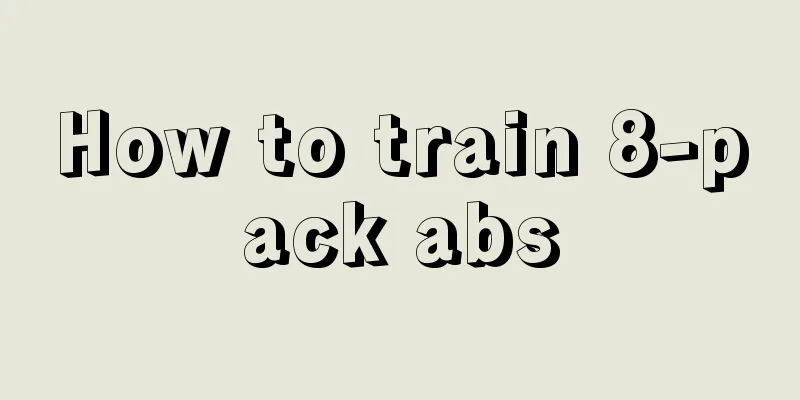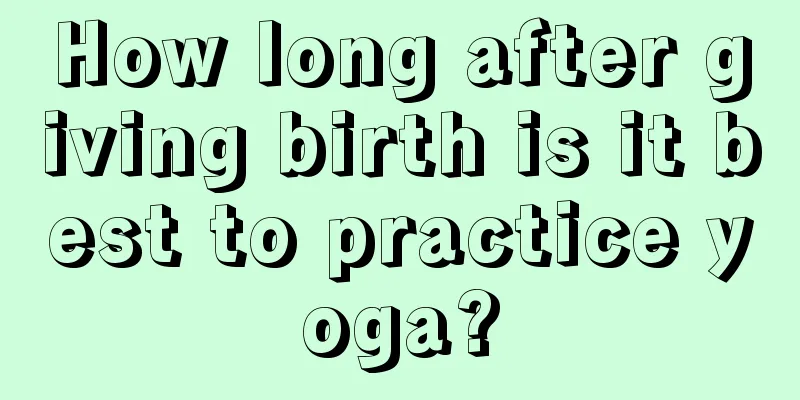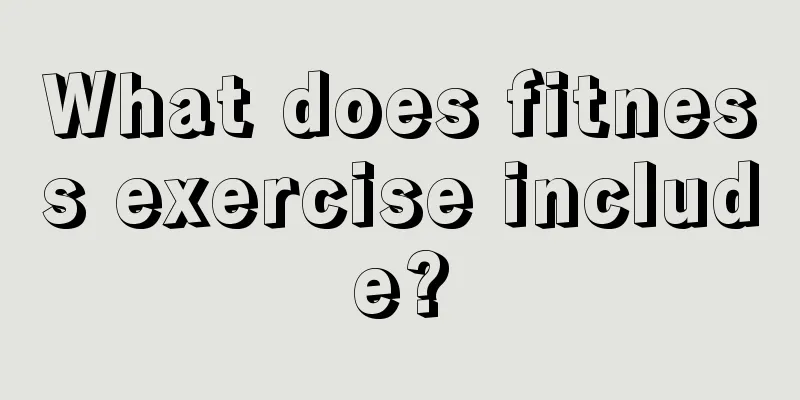What are the yoga breathing methods?

|
I believe everyone has seen yoga in daily life. Yoga is a way of exercising to regulate the body and mind. Doing yoga regularly can maintain your figure and help lose weight. It is also very beneficial to the body. Especially female friends should insist on doing yoga. Different yoga methods can achieve different exercise effects and are very good for the body. So what are the yoga breathing methods? Let us take a look at it together below. Complete Yoga Breathing Complete yogic breathing is a cornerstone of the yoga system, which teaches practitioners the correct natural breathing method. Be sure to incorporate full yogic breathing into your daily life and make it a habit. Over time, you will feel wonderful changes in your body. Posture: Adopt a relaxed sitting, lying or standing posture, loosen your clothes and belt, keep your spine and head perpendicular to the ground, let your arms hang naturally or place them on your legs, and relax your whole body. Steps: 1. Exhalation phase: Exhale slowly at the beginning, and use the method of contracting the abdomen to expel the gas out of the abdominal cavity. When the abdominal cavity is completely recessed into the body, begin to slowly contract the ribs to expel the remaining gas in the body out of the chest cavity until the gas is completely exhaled. This process takes about 5 seconds. Key points and tips: The difference between complete yoga breathing and general pranayama is that you exhale first and then inhale, allowing the lungs to become empty first. The essence lies in the movement of the diaphragm. When exhaling, you must concentrate and apply force to your lower abdomen slowly and evenly. The abdomen will gradually tighten inward due to the pressure until you feel that your belly is almost touching your back. This will massage your internal organs to the maximum extent and promote blood circulation in the internal organs. 2. Breath-holding stage: Stop breathing when the abdominal cavity and chest cavity are completely sunken, and hold for about 2 to 3 seconds. Key points and tips: During the breath-holding process, the waist should be straight and the sense should be kept sharp. If you feel that holding the breath brings tension to the brain, nerves and body, you should make adjustments immediately, otherwise the nervous system will become abnormal. 3. Inhalation phase: It is a completely opposite process to exhalation. We first relax the ribs to allow the gas to slowly fill the chest cavity. Try to inhale as much as possible to expand the chest. Then inhale gently and slowly relax the abdomen to gradually bulge. Inhalation takes about 5 seconds. At this point, we have completed a set of complete yoga breathing. Key points and tips: When inhaling, do not exert force on your shoulders, try to relax your upper body, and feel that the lower part is solid and the upper part is empty. If you use force on your shoulders, you will involuntarily apply force to your upper body, and the force will not be used in the lower abdomen where the force is actually applied. Efficacy: Complete yoga breathing expel more than three times the carbon dioxide as ordinary breathing methods. This method allows fresh air (called "Prana - the energy of life" in yoga) to be inhaled into the body according to the amount of carbon dioxide expelled. During the inhalation process, the diaphragm relaxes and descends, the internal organs recover from the squeezed state, and the fresh blood pumped from the heart fully enters the internal organs. This can replenish more oxygen to the brain and internal organs, enhance the functions of the digestive system and internal organs, improve the body's immunity, improve vitality and thinking ability, make you less prone to anxiety and tension, and have a good effect on cultivating concentration and attention. In addition, this breathing method can eliminate fatigue of muscles and internal organs, and has a calming effect on the autonomic nervous system disorder and endocrine stress state after strenuous exercise, deliver more nutrients and oxygen to the muscles, and promote human health. Note: When practicing, pay attention to adjusting the timing of exhaling, inhaling, and holding your breath. After practicing for a period of time, you can appropriately extend the duration of these three. In particular, you should master the timing of holding your breath. Yoga divides breath holding into two types, namely, breath holding after exhalation (external holding breath) and breath holding after inhalation (internal holding breath). Complete yoga breathing adopts the first method: external holding breath. The purpose of holding your breath is to revitalize the nervous system, so it must be done when the brain is relaxed. If your eyes become red, your body becomes lazy, and you become irritable during the process, these are dangerous signs, indicating that you are holding your breath excessively. If you only sweat slightly on the top of your head during the exercise, don't worry. This means that the toxins in your body are slowly being excreted and your body is being purified. This is a good sign. Cooling Breathing This is a breathing method that can calm the whole body. The main feature is to breathe in slowly through the mouth and then exhale slowly through both nostrils. This gradually calms the whole body and relaxes the nervous system. Posture: Sit in a comfortable position with your hands on your knees. Keep your upper spine, head, and neck straight at all times, close your eyes, and relax your whole body. Steps: Extend the tongue forward to touch the inside of the teeth, open the lips slightly, and leave a gap between the upper and lower teeth so that air can enter the mouth through the gap. Inhale through your mouth, feeling the air passing over your tongue. Take in as much air as you can without straining too much. Next, exhale slowly through both nostrils until all the air you inhaled is gone. This is a complete process, practice it at least 10 times. Effects: This method leads to muscle relaxation, blood purification, has a calming and relaxing effect on the entire body and nervous system. It also promotes the smooth flow of vital energy throughout the body, suppressing depression and mental tension. Description: Cooling Pranayama is practiced after practicing yoga postures and other Pranayamas. Then you can enter into meditation and feel the coolness from your mouth, throat, spinal nerves, etc., which makes you quiet and peaceful, and let this feeling spread throughout your body. The meditation process should be controlled within 3 minutes. Limitation: Hypertensive patients should not practice chin bandha and breath suspension at the same time when doing this exercise. Each practice is limited to 10 rounds. People with heart disease should not practice this method. What is described in the above article is a detailed introduction to yoga breathing methods. I believe that through the above content, everyone has a deeper understanding of the yoga breathing methods. Doing yoga regularly can help the body consume a lot of fat and achieve the effect of weight loss. It can also cultivate one's body and mind, which is very beneficial to the body. It is also very beneficial for women to maintain their figure. |
<<: Who is not suitable for hot yoga?
>>: What are the benefits of yoga breathing
Recommend
Is it okay to go running after dinner?
Running has become a very popular sport, because ...
What are some tips for losing weight?
Losing weight is a hot topic that people have alw...
How many sit-ups should girls do a day?
We all know that exercising more in life is good ...
How to add lubricating oil to a treadmill
Nowadays, people pay great attention to taking ca...
How to build muscle by running
Running is a common form of exercise that anyone ...
What is the muscle group training program?
When it comes to muscle training, many male frien...
What are the back muscle training methods?
When exercising your back muscles, you need to us...
Swimming Basics
Swimming is a good fitness activity. It not only ...
How to train muscle explosiveness
Through muscle exercises, you can keep your body ...
What should young people pay attention to when doing sports?
We all know that exercise can help our body impro...
What time is best to run at night?
For many people, the air is fresh in the morning,...
Can running help you lose weight?
For some people who want to stay in good shape, e...
Is it better to lose weight by playing badminton or running?
Is playing badminton to lose weight? Or is runnin...
What exercises can build muscle?
With the continuous progress of real society, man...
What are some quick ways to increase explosive power?
Many friends will find that their explosive power...









